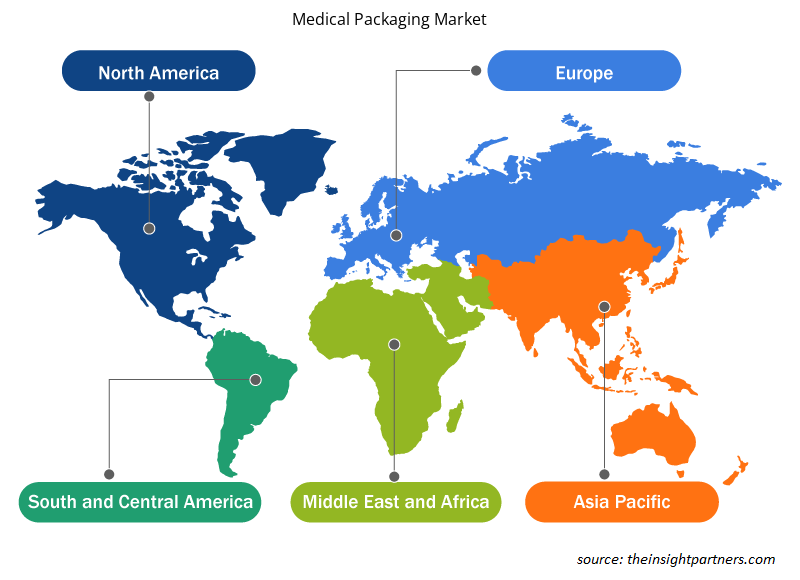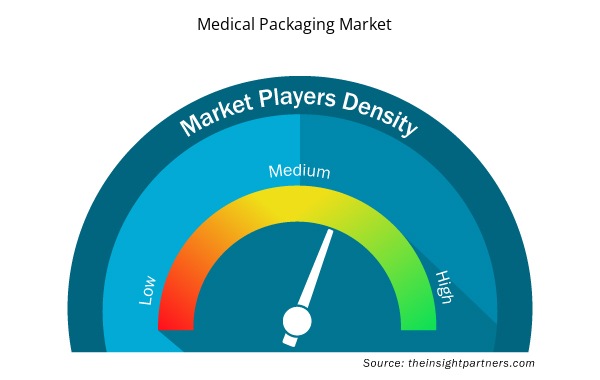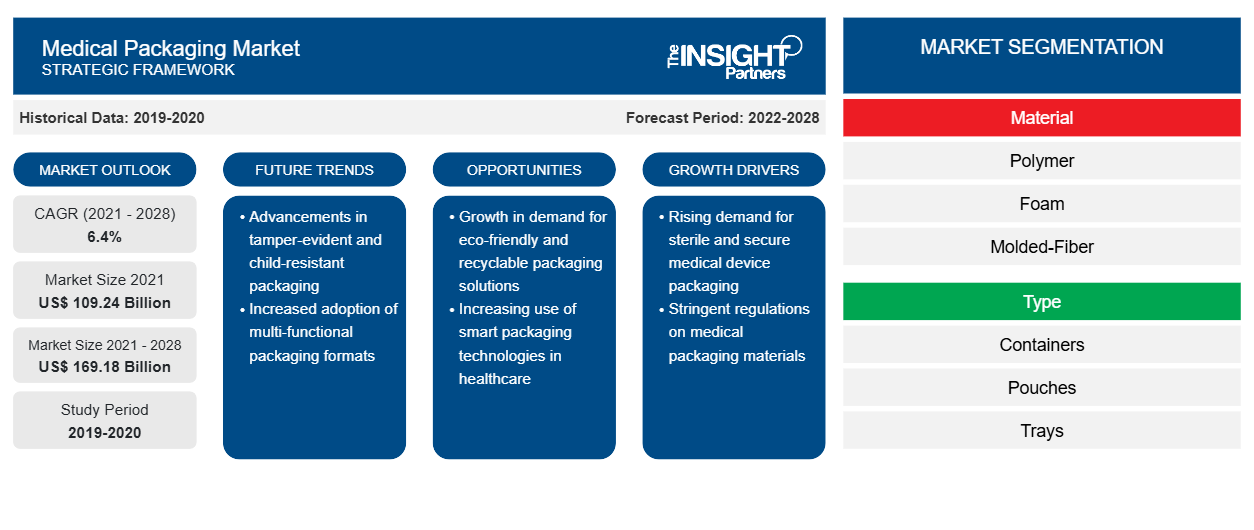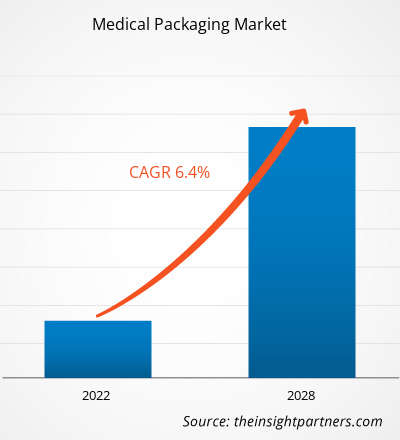من المتوقع أن يصل سوق التغليف الطبي إلى 169،183.91 مليون دولار أمريكي بحلول عام 2028 من 109،238.35 مليون دولار أمريكي في عام 2021؛ ومن المتوقع أن ينمو بمعدل نمو سنوي مركب قدره 6.4٪ من عام 2021 إلى عام 2028.
يعد التغليف الطبي ضروريًا للحفاظ على جودة المنتج وتشجيع الاستخدام الآمن والفعال. يتم التغليف لضمان سلامة المنتجات الطبية للتخزين والتوزيع والبيع والاستخدام. المادة المستخدمة في التغليف هي نظام حاجز معقم يحمي الأدوية والمعدات والمنتجات الطبية الأخرى. كما يتطلب التغليف الطبي جودة عالية من التعقيم لضمان خلو المنتج من التلوث. تعمل أنظمة التغليف الطبية هذه على زيادة سلامة المرضى وتعزيز أداء التغليف. تعمل عوامل مثل التركيز المتزايد على الراحة والقضايا البيئية وارتفاع الطلب على آليات منع التزييف على دفع سوق التغليف الطبي . ومع ذلك، من المتوقع أن تؤدي التقلبات في أسعار المواد الخام إلى تقييد نمو السوق إلى حد ما خلال فترة التنبؤ.
قم بتخصيص هذا التقرير ليناسب متطلباتك
ستحصل على تخصيص لأي تقرير - مجانًا - بما في ذلك أجزاء من هذا التقرير، أو تحليل على مستوى الدولة، وحزمة بيانات Excel، بالإضافة إلى الاستفادة من العروض والخصومات الرائعة للشركات الناشئة والجامعات
- احصل على أهم اتجاهات السوق الرئيسية لهذا التقرير.ستتضمن هذه العينة المجانية تحليلاً للبيانات، بدءًا من اتجاهات السوق وحتى التقديرات والتوقعات.
رؤى السوق
ارتفاع الطلب على آليات منع التزوير
وقد تم اكتشاف منتجات طبية مقلدة في أغلب الدول الأعضاء وجميع المناطق. ومن الأمثلة على ذلك الأدوية المستخدمة على نطاق واسع مثل أتورفاستاتين أو باراسيتامول؛ والأدوية ذات الاستخدام المحدود مثل هرمون النمو، وباكليتاكسيل، وفيلاجاستريم؛ وأنواع أخرى من الأدوية مثل السيلدينافيل والتادالافيل، فضلاً عن الأجهزة الطبية مثل العدسات اللاصقة، والواقيات الذكرية، والشبكات الجراحية، والشرائط التي يستخدمها مرضى السكري لمراقبة تركيزات الجلوكوز في الدم. وقد أثر التزوير على كل من المنتجات الباهظة الثمن والرخيصة والمنتجات العامة والعلامات التجارية. وتظهر المنتجات المقلدة في الصيدليات المجتمعية والمستشفيات وغيرها من الأماكن الأقل تنظيماً.
غالبًا ما يُفترض أن البلدان ذات الدخل المرتفع التي تتمتع بأنظمة تنظيمية متينة يمكنها استبعاد المنتجات الطبية دون المستوى والمزيفة من أسواقها بشكل فعال. ومع ذلك، يُظهر تحليل منظمة الصحة العالمية أن هذا ليس بالضرورة هو الحال، حيث تم تقديم تقارير عن هذه المنتجات من قبل بلدان في أوروبا الغربية وأمريكا الشمالية بالإضافة إلى بيئات أخرى ذات دخل مرتفع. على سبيل المثال، خلص مسح حديث في المملكة المتحدة، أجرته شركة Sapio Research بتكليف من شركة خاصة INCOPRO، إلى أن ما يقرب من ثلث (32٪) من أولئك الذين اشتروا دواءً مقلدًا واحدًا أو أكثر عانوا من مشكلة صحية نتيجة لذلك (INCOPRO، 2020). العديد من الحالات الأخرى الموثقة التي توفي فيها المرضى أو أصيبوا بأذى بسبب عملية شراء عبر الإنترنت. على سبيل المثال، في عام 2013، توفي أشخاص بعد تناول حبوب حمية مقلدة تم شراؤها من خلال بائع أدوية عبر الإنترنت. كانت الحبوب، التي تم بيعها كمساعد لفقدان الوزن من خلال العديد من الصيدليات غير المشروعة عبر الإنترنت، في الواقع مبيدًا للآفات له عواقب مميتة على البشر.
إن التهديد الذي تشكله الأدوية المقلدة على قطاع الأدوية العالمي هائل. فمن التركيبات المزيفة إلى المشكلات في عملية التصنيع، يعتقد بعض خبراء الصناعة أننا قد نشهد خسائر في الإيرادات تصل إلى 27 مليار يورو في أوروبا وحدها. وتعد رابطة مصنعي الهولوغرام الدولية (IHMA) مصدرًا جيدًا للخبرة في هذا المجال وتسلط الضوء على تقرير صناعي يشير إلى النمو المستمر لتقنيات التعبئة والتغليف لمكافحة التزييف. ووفقًا لرابطة مصنعي الهولوغرام الدولية، فإن تقرير "تقنيات مكافحة التزييف والمصادقة والتحقق" يشير إلى الخبرة الإضافية التي يجلبها التصوير المجسم إلى مصادقة منتجات التعبئة والتغليف. يعد الابتكار التكنولوجي في تقنيات مكافحة التزييف والمصادقة والتحقق عاملاً مهمًا يساهم في نمو السوق.
لقد عزز الطلب المتزايد على تقنيات مكافحة التزوير لحماية مصالح المرضى نمو قطاع التغليف الطبي.
رؤى مبنية على النوع
بناءً على النوع، يتم تصنيف سوق التغليف الطبي إلى حاويات وأكياس وصواني وحزم نفطة وقوارير وغيرها. في عام 2021، احتل قطاع الحاويات الحصة الأكبر من السوق، حسب النوع. ومن المتوقع أن ينمو قطاع الحزم النفطية بمعدل نمو سنوي مركب كبير خلال فترة التوقعات بسبب زيادة تطوير المنتجات وإطلاق المنتجات.
رؤى قائمة على المواد
بناءً على المادة، تم تقسيم سوق التغليف الطبي إلى البوليمر والرغوة والألياف المصبوبة والأقمشة غير المنسوجة والأفلام والورق والكرتون وغيرها. في عام 2021، احتل قطاع البوليمر الحصة الأكبر من السوق، حسب المادة. ومن المتوقع أيضًا أن ينمو القطاع المماثل بأسرع معدل خلال السنوات القادمة.
رؤى قائمة على التطبيق
بناءً على التطبيق، تم تقسيم سوق التغليف الطبي إلى الأجهزة الطبية والأدوية والتكنولوجيا الحيوية والمعدات والأدوات الطبية وغيرها. في عام 2021، احتل قطاع الأدوية والتكنولوجيا الحيوية الحصة الأكبر من السوق. ومن المتوقع أن ينمو نفس القطاع بمعدل نمو سنوي مركب كبير خلال فترة التنبؤ بسبب الإنتاج المتزايد لمنتجات الأدوية والتكنولوجيا الحيوية في الأسواق العالمية بسبب الانتشار المتزايد للأمراض المزمنة.
تتبنى العديد من الشركات العاملة في سوق التغليف الطبي استراتيجيات مثل إطلاق المنتجات، والاندماجات والاستحواذات، والتعاون، وابتكارات المنتجات، وتوسيع محفظة المنتجات لتوسيع بصمتها في جميع أنحاء العالم، والحفاظ على اسم العلامة التجارية، وتلبية الطلب المتزايد من المستخدمين النهائيين.
رؤى إقليمية حول سوق التغليف الطبي
لقد قام المحللون في Insight Partners بشرح الاتجاهات والعوامل الإقليمية المؤثرة على سوق التغليف الطبي طوال فترة التوقعات بشكل شامل. يناقش هذا القسم أيضًا قطاعات سوق التغليف الطبي والجغرافيا في جميع أنحاء أمريكا الشمالية وأوروبا ومنطقة آسيا والمحيط الهادئ والشرق الأوسط وأفريقيا وأمريكا الجنوبية والوسطى.

- احصل على البيانات الإقليمية المحددة لسوق التغليف الطبي
نطاق تقرير سوق التغليف الطبي
| سمة التقرير | تفاصيل |
|---|---|
| حجم السوق في عام 2021 | 109.24 مليار دولار أمريكي |
| حجم السوق بحلول عام 2028 | 169.18 مليار دولار أمريكي |
| معدل النمو السنوي المركب العالمي (2021 - 2028) | 6.4% |
| البيانات التاريخية | 2019-2020 |
| فترة التنبؤ | 2022-2028 |
| القطاعات المغطاة | حسب المادة
|
| المناطق والدول المغطاة | أمريكا الشمالية
|
| قادة السوق وملفات تعريف الشركات الرئيسية |
|
كثافة اللاعبين في سوق التغليف الطبي: فهم تأثيرها على ديناميكيات الأعمال
يشهد سوق التغليف الطبي نموًا سريعًا، مدفوعًا بالطلب المتزايد من المستخدم النهائي بسبب عوامل مثل تفضيلات المستهلك المتطورة والتقدم التكنولوجي والوعي المتزايد بفوائد المنتج. ومع ارتفاع الطلب، تعمل الشركات على توسيع عروضها والابتكار لتلبية احتياجات المستهلكين والاستفادة من الاتجاهات الناشئة، مما يؤدي إلى زيادة نمو السوق.
تشير كثافة اللاعبين في السوق إلى توزيع الشركات أو المؤسسات العاملة في سوق أو صناعة معينة. وهي تشير إلى عدد المنافسين (اللاعبين في السوق) الموجودين في مساحة سوق معينة نسبة إلى حجمها أو قيمتها السوقية الإجمالية.
الشركات الرئيسية العاملة في سوق التغليف الطبي هي:
- شركة أمكور المحدودة
- شركة دوبونت دي نيمورس
- شركة ميتسوبيشي للكيماويات
- شركة إس جي دي فارما
- 3م
إخلاء المسؤولية : الشركات المذكورة أعلاه ليست مرتبة بأي ترتيب معين.

- احصل على نظرة عامة على أهم اللاعبين الرئيسيين في سوق التغليف الطبي
سوق التغليف الطبي – حسب النوع
- الحاويات
- الأكياس
- صواني
- الحزم البثورية
- قوارير
- آحرون
سوق التغليف الطبي – حسب المادة
- البوليمر
- رغوة
- الألياف المصبوبة
- قماش غير منسوج
- الأفلام
- الورق والكرتون
- آحرون
سوق التغليف الطبي – حسب التطبيق
- الأجهزة الطبية
- الصيدلة والتكنولوجيا الحيوية
- المعدات والأدوات الطبية
- آحرون
سوق التغليف الطبي – حسب المنطقة الجغرافية
أمريكا الشمالية
- نحن
- كندا
- المكسيك
أوروبا
- فرنسا
- ألمانيا
- إيطاليا
- المملكة المتحدة
- إسبانيا
- بقية أوروبا
آسيا والمحيط الهادئ (APAC)
- الصين
- الهند
- كوريا الجنوبية
- اليابان
- أستراليا
- بقية آسيا والمحيط الهادئ
الشرق الأوسط وأفريقيا
- جنوب أفريقيا
- المملكة العربية السعودية
- الامارات العربية المتحدة
- بقية الشرق الأوسط وأفريقيا
أمريكا الجنوبية (SAM)
- البرازيل
- الأرجنتين
- بقية أمريكا الجنوبية والوسطى
نبذة عن الشركة
- شركة أمكور المحدودة
- شركة دوبونت دي نيمورس
- شركة ميتسوبيشي للكيماويات
- شركة إس جي دي فارما
- 3م
- خدمات الأدوية الغربية، المحدودة
- شركة أفيري دينيسون
- شركة سونوكو للمنتجات
- شركة سي سي إل للصناعات المحدودة
- شركة ويست روك
- التحليل التاريخي (سنتان)، السنة الأساسية، التوقعات (7 سنوات) مع معدل النمو السنوي المركب
- تحليل PEST و SWOT
- حجم السوق والقيمة / الحجم - عالميًا وإقليميًا وقطريًا
- الصناعة والمنافسة
- مجموعة بيانات Excel


- Webbing Market
- Sweet Potato Market
- Emergency Department Information System (EDIS) Market
- Environmental Consulting Service Market
- Saudi Arabia Drywall Panels Market
- Sexual Wellness Market
- Asset Integrity Management Market
- Virtual Production Market
- Equipment Rental Software Market
- Europe Surety Market

Report Coverage
Revenue forecast, Company Analysis, Industry landscape, Growth factors, and Trends

Segment Covered
This text is related
to segments covered.

Regional Scope
North America, Europe, Asia Pacific, Middle East & Africa, South & Central America

Country Scope
This text is related
to country scope.
الأسئلة الشائعة
Key factors that are driving the growth of this market include increased emphasis on convenience and environmental issues, rise in demand for counterfeit prevention mechanisms drive the growth of the medical packaging market.
Global medical packaging market is segmented by region into North America, Europe, Asia Pacific, Middle East & Africa and South & Central America. In North America, the U.S. is the largest market for medical packaging. The US is estimated to hold the largest share in the medical packaging market during the forecast period. The projected growth of the medical packaging market in the US is attributed to the rise in demand for counterfeit prevention mechanisms, increased emphasis on convenience and environmental issues. The Asia Pacific region is expected to account for the fastest growth in the medical packaging market. Rapid development of healthcare infrastructure along with pharmaceutical production hub is expected to impact the growth of the market in the region.
Medical packaging is essential in sustaining product quality and encourage safe and effective use. Packaging is done for the safety of medical products for storage, distribution, sale, and use. The material used for packaging is sterile barrier systems that safeguard the drugs, equipment, and other medical products. Also, the medical packaging requires a high quality of sterility to ensure that the product is free from contamination. These medical packaging systems increase patient safety and enhance packaging performance.
The List of Companies - Medical Packaging Market
- Amcor plc
- DuPont de Nemours, Inc.
- Mitsubishi Chemical Corporation
- SGD Pharma
- 3M
- West Pharmaceutical Services, Inc
- Avery Dennison Corporation
- Sonoco Products Company
- CCL Industries Inc.
- WestRock Company
The Insight Partners performs research in 4 major stages: Data Collection & Secondary Research, Primary Research, Data Analysis and Data Triangulation & Final Review.
- Data Collection and Secondary Research:
As a market research and consulting firm operating from a decade, we have published and advised several client across the globe. First step for any study will start with an assessment of currently available data and insights from existing reports. Further, historical and current market information is collected from Investor Presentations, Annual Reports, SEC Filings, etc., and other information related to company’s performance and market positioning are gathered from Paid Databases (Factiva, Hoovers, and Reuters) and various other publications available in public domain.
Several associations trade associates, technical forums, institutes, societies and organization are accessed to gain technical as well as market related insights through their publications such as research papers, blogs and press releases related to the studies are referred to get cues about the market. Further, white papers, journals, magazines, and other news articles published in last 3 years are scrutinized and analyzed to understand the current market trends.
- Primary Research:
The primarily interview analysis comprise of data obtained from industry participants interview and answers to survey questions gathered by in-house primary team.
For primary research, interviews are conducted with industry experts/CEOs/Marketing Managers/VPs/Subject Matter Experts from both demand and supply side to get a 360-degree view of the market. The primary team conducts several interviews based on the complexity of the markets to understand the various market trends and dynamics which makes research more credible and precise.
A typical research interview fulfils the following functions:
- Provides first-hand information on the market size, market trends, growth trends, competitive landscape, and outlook
- Validates and strengthens in-house secondary research findings
- Develops the analysis team’s expertise and market understanding
Primary research involves email interactions and telephone interviews for each market, category, segment, and sub-segment across geographies. The participants who typically take part in such a process include, but are not limited to:
- Industry participants: VPs, business development managers, market intelligence managers and national sales managers
- Outside experts: Valuation experts, research analysts and key opinion leaders specializing in the electronics and semiconductor industry.
Below is the breakup of our primary respondents by company, designation, and region:

Once we receive the confirmation from primary research sources or primary respondents, we finalize the base year market estimation and forecast the data as per the macroeconomic and microeconomic factors assessed during data collection.
- Data Analysis:
Once data is validated through both secondary as well as primary respondents, we finalize the market estimations by hypothesis formulation and factor analysis at regional and country level.
- Macro-Economic Factor Analysis:
We analyse macroeconomic indicators such the gross domestic product (GDP), increase in the demand for goods and services across industries, technological advancement, regional economic growth, governmental policies, the influence of COVID-19, PEST analysis, and other aspects. This analysis aids in setting benchmarks for various nations/regions and approximating market splits. Additionally, the general trend of the aforementioned components aid in determining the market's development possibilities.
- Country Level Data:
Various factors that are especially aligned to the country are taken into account to determine the market size for a certain area and country, including the presence of vendors, such as headquarters and offices, the country's GDP, demand patterns, and industry growth. To comprehend the market dynamics for the nation, a number of growth variables, inhibitors, application areas, and current market trends are researched. The aforementioned elements aid in determining the country's overall market's growth potential.
- Company Profile:
The “Table of Contents” is formulated by listing and analyzing more than 25 - 30 companies operating in the market ecosystem across geographies. However, we profile only 10 companies as a standard practice in our syndicate reports. These 10 companies comprise leading, emerging, and regional players. Nonetheless, our analysis is not restricted to the 10 listed companies, we also analyze other companies present in the market to develop a holistic view and understand the prevailing trends. The “Company Profiles” section in the report covers key facts, business description, products & services, financial information, SWOT analysis, and key developments. The financial information presented is extracted from the annual reports and official documents of the publicly listed companies. Upon collecting the information for the sections of respective companies, we verify them via various primary sources and then compile the data in respective company profiles. The company level information helps us in deriving the base number as well as in forecasting the market size.
- Developing Base Number:
Aggregation of sales statistics (2020-2022) and macro-economic factor, and other secondary and primary research insights are utilized to arrive at base number and related market shares for 2022. The data gaps are identified in this step and relevant market data is analyzed, collected from paid primary interviews or databases. On finalizing the base year market size, forecasts are developed on the basis of macro-economic, industry and market growth factors and company level analysis.
- Data Triangulation and Final Review:
The market findings and base year market size calculations are validated from supply as well as demand side. Demand side validations are based on macro-economic factor analysis and benchmarks for respective regions and countries. In case of supply side validations, revenues of major companies are estimated (in case not available) based on industry benchmark, approximate number of employees, product portfolio, and primary interviews revenues are gathered. Further revenue from target product/service segment is assessed to avoid overshooting of market statistics. In case of heavy deviations between supply and demand side values, all thes steps are repeated to achieve synchronization.
We follow an iterative model, wherein we share our research findings with Subject Matter Experts (SME’s) and Key Opinion Leaders (KOLs) until consensus view of the market is not formulated – this model negates any drastic deviation in the opinions of experts. Only validated and universally acceptable research findings are quoted in our reports.
We have important check points that we use to validate our research findings – which we call – data triangulation, where we validate the information, we generate from secondary sources with primary interviews and then we re-validate with our internal data bases and Subject matter experts. This comprehensive model enables us to deliver high quality, reliable data in shortest possible time.


 احصل على عينة مجانية لهذا التقرير
احصل على عينة مجانية لهذا التقرير